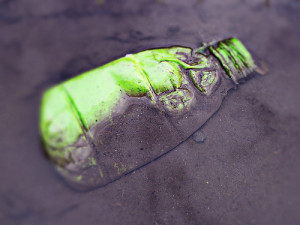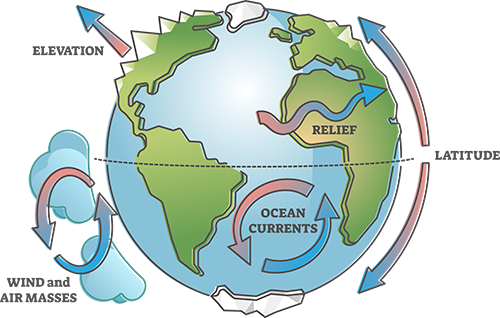Local businesses, big-box chains, national media, small-town shops…almost every market we interact with daily is pushing the “going green” slogan.
But even the most educated greenie with the best intentions can miss the fine print. Here are some common mistakes to look for when embarking on your own eco journey.
1. Tossing “biodegradable” items in the trash
 The packaging says “biodegradable,” so I can just toss it in the garbage and it will decompose, right? Not exactly. Photo: Flickr/the-g-uk
The packaging says “biodegradable,” so I can just toss it in the garbage and it will decompose, right? Not exactly. Photo: Flickr/the-g-ukGood intention
Buying products labeled as “biodegradable” will reduce the amount of trash in landfills.
What goes wrong
The term “biodegradable” means that these products are capable of being decomposed by the action of biological agents, especially bacteria. The common misconception is if it’s biodegradable, it can be tossed or buried anywhere without consequence.
But a 2001 study proves just the opposite. A group of researchers from the University of Arizona excavated 21 landfills across North America and reported finding hundreds of undecomposed hot dogs, corn starch and lettuce dating back to the 1960s. They also found 2,425 newspapers – still readable – that were essentially used to date the food.
This is because for sanitary reasons, modern landfills are lined on the bottom with clay and plastic to keep waste from escaping into the soil. In order to reduce odor, landfills are covered daily with a layer of earth.
According to a 2007 Slate article, “The landfill, then, acts like a trash tomb – the garbage within receives little air, water or sunlight. This means that even readily degradable waste objects, including paper and food scraps, are more likely to mummify than decompose.”
The right way to do it
Buying biodegradable items is still one step in the right direction. However, these items are sure to break down in a commercial composting system. Instead of tossing them in the trash, look for local composting outlets that have high-heat facilities that promote aerobic conditions.
Read more
What “Bio” Really Means
2. Upgrading appliances without recycling the old
Good intention
Upgrading to a certified Energy Star appliance can save on your annual energy costs: $135 (clothes washer), $200 to $300 (refrigerator), $40 (dishwasher).
What goes wrong
When making the upgrade to a more energy-efficient appliance, some consumers often forget about properly disposing of their old model. This poses a huge threat to the ozone layer.
According to the U.S. EPA, “Household refrigerators and freezers manufactured before 1995 typically contain chlorofluorocarbon (CFC) refrigerant. Most window air-conditioning units and dehumidifiers contain hydrochlorofluorocarbon (HCFC) refrigerant. CFCs and HCFCs are ozone-depleting substances that, if released to the environment, destroy the protective ozone layer above the earth.”
Each year, Americans dispose of roughly 10 million refrigerators and freezers that contain ozone-destroying and heat-trapping CFCs or HFCs.
The right way to do it
When purchasing a new model, ask your retailer if it participates in an appliance take-back program. The EPA’s new voluntary Responsible Appliance Disposal (RAD) Program promotes environmentally responsible disposal of household appliances, and will significantly reduce emissions of ozone depleting substances and greenhouse gases.
Read more
Cash for Appliances is Official
3. Installing a programmable thermostat, but not weatherizing your home
Good intention
A programmable thermostat will save you $180 in energy costs every year you use it. That’s $1,800 over 10 years.
What goes wrong
While investing in a programmable thermostat will save a significant amount of money and energy, some homeowners are unaware of leaks in the home that virtual drains on your home’s energy.
The average, unweatherized U.S. home leaks air at a rate equivalent to a 4-square-foot hole in the wall, according to the “Solar Living Sourcebook” by John Schaeffer.
If that stat isn’t enough consider that in California, the average duct system loses 30 percent of its heating or cooling to leaks. Sealing and insulating ducts can improve the efficiency of your heating and cooling system by as much as 20 percent – and sometimes much more.
The right way to do it
To detect them in your home, look to areas where different materials meet, such as between brick and wood siding, between foundation and walls and between the chimney and siding. Focus on sealing ducts that run through the attic, crawlspace, unheated basement or garage.
Use duct sealant (mastic) or metal-backed (foil) tape to seal the seams and connections of ducts. After sealing the ducts in those spaces, wrap them in insulation to keep them from getting hot in the summer or cold in the winter. Next, look to seal any other ducts that you can access in the heated or cooled part of the house.
Read more
Weatherize Your Home
4. Switching to CFLs, but tossing after use
Good intention
An Energy Star-qualified CFL will save about $30 over its lifetime and pay for itself in about 6 months. Plus, it uses 75 percent less energy and lasts about 10 times longer than an incandescent bulb.
What goes wrong
While a CFL may last longer, disposal is harder than an incandescent bulb. CFLs contain trace amounts of mercury (about 4 milligrams on average) sealed within glass tubing, so they can’t be tossed in the trash.
The right way to do it
The EPA recommends that burnt out CFLs be returned to local recycling centers or household hazardous waste events that accept CFLs. Use Earth911 to find a local recycling center for CFLs.
Also, note that you’ll maximize the lifetime savings and effectiveness of your CFLs by keeping them on for 15 minutes or more at a time.
Read more
Yes, You Pay More For CFLs, But Are They Worth It?
5. Using recycled-content paper towels over reusables
 Tired of seeing an empty paper towel tube on your counter? Try opting for reusable cloths instead. Photo: Flickr/CraftyGoat
Tired of seeing an empty paper towel tube on your counter? Try opting for reusable cloths instead. Photo: Flickr/CraftyGoatGood intention
Paper towels made from recycled materials reduce our need for energy-intensive virgin fiber.
What goes wrong
On the short term, you can reduce your paper towel waste by using less and using towels made from recycled materials.
Some companies, like Seventh Generation, have towels made from 100 percent post-consumer paper. You can also use unsoiled paper towels in mulch and compost.
However, the problem with paper towels is two-fold: They don’t contain significant amounts of fiber for recycling, meaning incentive to recycle them is low (less fiber = less money). Also, they are often dirty or wet, which degrades them further and makes them non-recyclable.
The right way to do it
Buy reusable napkins and cleaning cloths to reduce your usage of rolls (and rolls) of paper towels. You can save up to $150 per year for a household that uses two rolls per week, conserving 30 pounds or more of tissue-grade paper.
Read more
Ditch Your Disposables
6. Driving a hybrid like a regular car
Good intention
Hybrid vehicles can reduce air emissions of smog-forming pollutants by up to 90 percent and cut carbon dioxide emissions in half, according to Idaho Department of Environmental Quality.
What goes wrong
Many drivers forget about simple hypermiling techniques on the road. Accelerating quickly and pushing the engine to its maximum burns up fuel (and battery) much more quickly than gradual acceleration.
Also, last-minute stops or speeding up only to halt at a red light means more fuel burned. Most drivers apply their brakes between 10 and 25 percent more times than necessary.
The right way to do it
Hypermiling is different in a hybrid because the car uses the energy you save by regenerating the battery. A more powerful battery will give you more drive time in EV mode, resulting in less gas used.
Using hypermiling techniques can result in 35 percent better fuel mileage out of your current vehicle (even if it’s not a hybrid). It can be tough to slow down and mellow out, but it pays back in big savings on fuel consumption.
Read more
Test Spin With Ford
7. Planting a garden with pesticides
Good intention
Planting a home garden can provide your home with fresh, locally grown produce. This saves you both money, time and carbon emissions associated with transportation.
What goes wrong
Many gardeners use pesticides in order to control the pests that often creep around plants, this includes mice, insects, weeds, fungi and bacteria.
The EPA evaluates pesticides to ensure that they will not have unreasonable adverse effects on humans, the environment and non-target species, but because they are designed to kill or otherwise adversely affect living organisms, pesticides may pose some risk to humans, animals or the environment.
Some pesticides are more hazardous than others; the hazard may be from ingestion, getting the substance on the skin or in the eyes, or inhaling it.
The right way to do it
In addition to planting a variety of veggies and herbs, add some flowers to the mix to help ward off pests, since you’ll be eschewing chemical insecticides. Flowers and herbs attract beneficial insects like ladybugs, which keep aphids and other pests in check.
Putting a birdbath nearby will also invite more fine feathered friends, who will also be happy to help your cause by feasting on bugs.
You can also buy chemical-free fertilizers if your garden needs an additional boost. Just be aware that the word “organic” is not regulated the same way for fertilizers as it is for foods.
Biologically-based pesticides, such as pheromones and microbial pesticides, are becoming increasingly popular and often are safer than traditional chemical pesticides. In addition, EPA is registering reduced-risk conventional pesticides in increasing numbers.
info from http://earth911.com/news/2010/05/17/oops-eco-intentions-gone-wrong/



